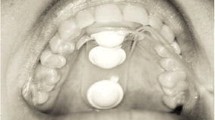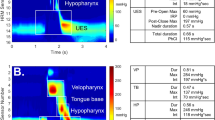Abstract
Research demonstrates that varying sensory input, including the characteristics of a bolus, changes swallow physiology. Altering the consistency of fluids is a common compensatory technique used in dysphagia management to facilitate change. However, it is not known what variations in viscosity can be perceived in the oral cavity or oropharynx or if age affects oral and oropharyngeal perceptions of fluid viscosity. This study aims to establish the ability of normal adults to perceive fluid viscosity in the oral cavity and oropharynx and to determine if, within this population, there are age-related changes in oral and oropharyngeal perceptions. Sensitivity was established by deriving the exponent for the psychophysical law for fluid viscosity in both the oral cavity and the oropharynx, using modulus-free magnitude estimation with Newtonian fluids of corn syrup and water. Sixty normal volunteers, aged 21–84 years, participated. Results indicate that the exponent for oral perception of fluid viscosity was 0.3298, while for oropharyngeal perception it was 0.3148. Viscosity perception deteriorates with increasing age. Men exhibited a more marked deterioration in sensitivity than women. This study contributes to the literature on oral and oropharyngeal perceptions and on aging. The results provide a basis for work with individuals with dysphagia.

Similar content being viewed by others
References
Logemann JA: Evaluation and Treatment of Swallowing Disorders, 2nd ed. Austin, TX: Pro-Ed, 1998
Miller AJ: The Neuroscientific Principles of Swallowing and Dysphagia. San Diego, CA: Singular, 1999
Crary MA, Groher ME: Introduction to Adult Swallowing Disorders. St Louis, MO: Elsevier Science, 2003
Logemann JA, Pauloski BR, Rademaker AW, Colangelo LA, Kahrilas PJ, Smith CH: Oropharyngeal swallow in younger and older men: temporal and biomechanical characteristics of oropharyngeal swallow in younger and older men. J Speech Lang Hear Res 43:1264–1274, 2000
Logemann JA: Effects of aging on the swallowing mechanism. Otolaryngol Clin North Am 23:1045–1056, 1990
Robbins JA, Hamilton JW, Lof GL, Kempster GB: Oropharyngeal swallowing in normal adults of different ages. Gastroenterology 103:823–829, 1992
Logemann JA, Pauloski BR, Colangelo L, Lazarus C, Fujiu M, Kahrilas PJ: Effects of a sour bolus on oropharyngeal swallowing measures in patients with neurogenic dysphagia. J Speech Hear Res 38:556–563, 1995
Kagel MC, Leopold NA: Dysphagia in Huntington’s Disease: a 16-year retrospective. Dysphagia 7:106–114, 1992
Pelletier CA, Lawless HT: Effect of citrus acid and citric acid-sucrose mixtures on swallowing in neurogenic oropharyngeal dysphagia. Dysphagia 18:231–241, 2003
Chi-Fishman G, Sonies BC: Effects of systematic bolus viscosity and volume changes on hyoid movement kinematics. Dysphagia 17:278–287, 2002
Kahrilas PJ, Logemann JA: Volume accommodation during swallowing. Dysphagia 8:259–265, 1993
Lazarus CL, Logemann JA, Rademaker AW, Kahrilas PJ, Pajak T, Lazar R. Halper A: Effects of bolus volume, viscosity, and repeated swallows in nonstroke subjects and stroke patients. Arch Phys Med Rehabil 74:1066–1070, 1993
Logemann JA, Kahrilas PJ, Cheng J, Pauloski BR, Gibbons PJ, Rademaker AW, Lin S: Closure mechanisms of laryngeal vestibule during swallow. Am J Physiol 262(2 Pt 1):G338–G344, 1992
Bisch EM, Logemann JA, Rademaker AW, Kahrilas PJ, Lazarus CL: Pharyngeal effects of bolus volume, viscosity, and temperature in patients with dysphagia resulting from neurologic impairment and in normal subjects. J Speech Hear Res 37:1041–1049, 1994
Ren J, Shaker R, Zamir Z, Dodds WJ, Hogan WJ, Hoffmann RG: Effect of age and bolus variables on the coordination of the glottis and upper esophageal sphincter during swallowing. Am J Gastroenterol 88:665–669, 1993
Ali GN, Laundl TM, Wallace KL, deCarle DJ, Cook IJ: Influence of cold stimulation on the normal pharyngeal swallow response. Dysphagia 11:2–8, 1996
Miller JL, Watkin KL: The influence of bolus volume and viscosity on anterior lingual force during the oral stage of swallowing. Dysphagia 11:117–124, 1996
Dantas RO, Dodds WJ: Effect of bolus volume and consistency on swallow-induced submental and infrahyoid electromyographic activity. Braz J Med Biol Res 23:37–44, 1990
Dantas RO, Kern MK, Massey BT, Dodds WJ, Kahrilas PJ, Brasseur JG, Cook IJ: Effect of swallowed bolus variables on the oral and pharyngeal phases of swallowing. Am J Physiol 258:G675–G681, 1990
Ekberg O, Liedberg B, Öwall B: Barium and meat – a comparison between pharyngeal swallow of fluid and solid boluses. Acta Radiol Diagn 27:701–704, 1986
Reimers-Neils L, Logemann JA, Larson C: Viscosity effects on EMG activity in normal swallow. Dysphagia 9:101–106, 1994
Gescheider GA: Psychophysics: The Fundamentals, 3rd ed. Mahwah, NJ: Lawrence Erlbaum, 1997
Stevens SS: Psychophysics, rev ed. New Brunswick, NJ: Transaction Books, 1986
Christensen CM, Casper LM: Oral and nonoral perception of solution viscosity. J Food Sci 52:445–447, 1987
Rao MA: Rheology of liquid foods – a review. J Texture Stud 8:135–168, 1977
Smith CH, Logemann JA, Burghardt WR, Carrell TD, Zecker SG: Oral sensory discrimination of fluid viscosity. Dysphagia 12:68–73, 1997
Cichero JAY, Jackson O, Halley PJ, Murdoch BE: How thick is thick? Multicenter study of the rheological and material property characteristics of mealtime fluids and videofluoroscopy fluids. Dysphagia 15:188–200, 2000
Steele CM, Van Lieshout PHHM, Goff HD: The rheology of liquids: A comparison of clinicians’ subjective impressions and objective measurement. Dysphagia 18:182–195, 2003
Hanger LY, Penfield MP: Sample/rinse temperature effects on discrimination of sweet and salty differences in a food system. J Sens Stud 8:1–11, 1993
Marks LE: Sensory Processes: The New Psychophysics. New York: Academic Press, 1974
Stevens SS: Issues in psychophysical measurement. Psychol Rev 78:426–450, 1971
Wilkinson L: Systat: the System for Statistics. Evanston, IL: SYSTAT, Inc, 1992
Stevens SS, Guirao M: Scaling of apparent viscosity. Science 144:1157–1158, 1964
Moskowitz HR: Scales of subjective viscosity and fluidity of gum solutions. J Texture Stud 3:89–100, 1972
Calhoun KH, Gibson B, Hartley L, Minton J, Hokanson J: Age-related changes in oral sensation. Laryngoscope 102:109–116, 1992
Green BG: Oral perception of the temperature of liquids. Percept Psychophys 39:19–24, 1986
Green BG, Gelhard B: Perception of temperature on oral and facial skin. Somatosens Res 4:191–200, 1987
Grover C, Craske B: Perceiving tongue position. Perception 21:661–670, 1992
McDonald ET, Aungst LF: Studies in oral sensorimotor function. In: Bosma JF (ed.): Symposium on Oral Sensation and Perception. Springfield, IL: Charles C Thomas, 1967, pp 202–220
Williams WN, La Pointe L: Intra-oral recognition of geometric forms by normal subjects. Percept Motor Skills 32:419–426, 1971
Fucci D, Petrosino L: Lingual vibrotactile sensation magnitudes: Comparison of suprathreshold responses in men and women. Percept Psychophys 33:93–95, 1983
Fucci D, Petrosino LA, Harris D, Randolph-Tyler E: Effects of aging on responses to suprathreshold lingual vibrotactile stimulation. Percept Motor Skills 64:683–694, 1987
Fucci D, Harris D, Petrosino L: Sensation magnitude scales for vibrotactile stimulation of the tongue and thenar eminence. Percept Motor Skills 58:843–848, 1984
Kesarwani A, Antonyshyn O, Mackinnon SE, Gruss JS, Novak C, Kelly L: Facial sensibility testing in the normal and posttraumatic population. Ann Plast Surg 22:416–425, 1989
Petrosino L, Fucci D, Robey RR: Changes in lingual sensitivity as a function of age and stimulus exposure time. Percept Motor Skills 55:1083–1090, 1982
Smith CH, Logemann JA, Colangelo LA, Rademaker AW, Pauloski BR: Incidence and patient characteristics associated with silent aspiration in the acute care setting. Dysphagia 14:1–7, 1999
Mu L, Sanders I: Sensory nerve supply of the human oro- and laryngopharynx: A preliminary study. Anat Rec 258:406–420, 2000
Wood FW: Psychophysical studies on the consistency of liquid foods. Rheology and Texture of Foodstuffs, Society of Chemical Industry, Monogr No. 27
Glassburn DL, Deem JF: Thickener viscosity in dysphagia management: variability among speech-language pathologists. Dysphagia 13:218–222, 1998
Acknowledgments
The authors thank Celia Berdes and the Beuhler Center on Aging, Northwestern University; the participants who took the time to participate in this study; and the two anonymous reviewers for this manuscript. Funding was provided by NIH/NCI grant #P01 CA 40007.
Author information
Authors and Affiliations
Corresponding author
Appendix: Description of the Exponent of the Psychophysical Law
Appendix: Description of the Exponent of the Psychophysical Law
When the psychophysical power law is described mathematically, it can be quantified and the power component is termed the exponent of the relation. This relation can be defined thus:
where ψ is the psychological magnitude, φ is the intensity of the physical stimulus, k is a constant determined by the choice of unit selected for measurement, and β is the exponent. The exponent is the only part of this equation that changes depending on the sensory system being examined. The value of the exponent (β) serves as a kind of signature that may differ from one sensory continuum to another. (e.g., taste in the form of salt has an exponent of 1.4). When we plot the results of magnitude estimation experiments, the exponent of the psychophysical law is graphically displayed reflecting the rate at which a stimulus response grows in relation to the stimulus. The psychophysical law for electric shock, with an exponent of more than one (3.5), when displayed graphically on ordinary graph paper is a line that is concave upward, ascending in an ever-steepening slope. Length has an exponent of 1.1 and is almost a straight line, while brightness, with an exponent of less than one (0.33), has a curvature downward, with the line becoming ever more horizontal (Stevens 1986). Thus, the exponent of the psychophysical law determines, and reflects, the curvature of this type of line plot. An interesting feature of the power function is that, if it is plotted with logarithmic scales on both axes, all the lines become straight lines. The slope of the power function for electrical shock is steep, while that for brightness is shallow, and length is approximately 45° to the horizontal and vertical axes, but all are straight lines. In terms of logarithms, the power law equation becomes
This formula describes a straight line in log-log coordinates, and the exponent (β) becomes the slope of the line. The exponent is directly displayed in the slope of the power function. Alternatively one can say that the slope of the line is a direct measure of the exponent (Fig. 1).
Rights and permissions
About this article
Cite this article
Smith, C.H., Logemann, J.A., Burghardt, W.R. et al. Oral and Oropharyngeal Perceptions of Fluid Viscosity Across the Age Span. Dysphagia 21, 209–217 (2006). https://doi.org/10.1007/s00455-006-9045-4
Published:
Issue Date:
DOI: https://doi.org/10.1007/s00455-006-9045-4




